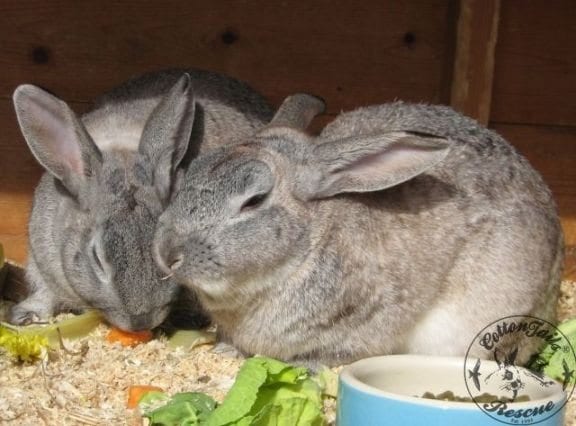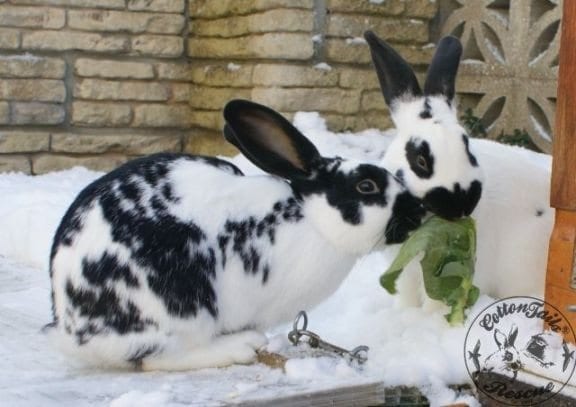Most rabbits are territorial by nature. However, this does not mean that they have to lead solitary lives. Rabbits that live in compatible pairs or small groups benefit in many ways, including companionship, mental and physical stimulation, and not least a grooming partner!
Once you see how happy rabbits are when living in bonded pairs you will vow never to keep a rabbit on its own again, and although there is always an exception to any rule, the large majority of rabbits can be successfully matched so long as care is taken with choosing a suitable partner and giving thought to their environment. All our rabbits at CottonTails® rabbit and guinea pig rescue are re-homed in pairs, so we supervise over 300 speed-dating match-ups every year. This experience has shown that the large majority of bunny “arranged marriages” are successful.
Neutering of both partners is vital for long-term success, and ideally this should be carried out prior to matching or, in the case of baby rabbits, as soon as they mature. With males this is usually between 10-16 weeks of age (as soon as the testicles descend), females being spayed from 14 weeks onwards so long as they weigh over 1kg. My observations have shown that young rabbits recover just as fast if not quicker than adults, and waiting until the rabbits are 5-6 months old can cause many problems, including fighting or breeding. Before looking at possible pairing combinations, there are some general points that should be kept in mind when matching rabbits. Of the two general methods of bonding rabbits, fast-track system and the slow approach, it is the former that I will discuss first, as this is the most efficient method for most rabbits.
With the fast-track system, neutral territory is usually necessary for the initial encounter and for the first few days thereafter, until the rabbits have accepted each other. This is somewhere where neither rabbit has been before, but it must be large enough to allow plenty room for them to get away from each other if necessary. This could be a shed, a garage, a greenhouse, or anywhere that they will be safe to live together until they have bonded. This usually takes about a week, by which time they should be enjoying each other’s company by grooming each other and choosing to sit together. They should be provided with distractions such as cardboard boxes (also useful to hide in), and their usual food, hay and water during this time.
It is best to take your rabbit with you when going to choose a new partner for him or her so that they can meet in neutral territory initially and then travel back together in the same carrying box (see below for details of this initial encounter). Travelling together is a proven method of kick-starting the bonding process as both rabbits are afraid during the journey home and look to each other for support and comfort. An extra box can be taken just in case the two have to be separated on route, but this is extremely rare as once the journey starts the rabbits usually sit very still and quiet.
Don’t forget to find out what food your new rabbit has been fed on so you can make any diet changes very gradually.
THE INITIAL ENCOUNTER
This should take place on territory not known by either rabbit, using an existing territory only if that particular individual is extremely nervous and submissive towards other rabbits. You usually get a very good indication whether or not the new combination has a chance of working within the first 15 minutes, although it is normal for both rabbits to ignore each other for a while to start with.
Common initial behaviours include mounting by one or both parties, often at the wrong end and sometimes both rabbits trying to mount each other at the same time, resulting in them spinning round and round in circles with ever-increasing speed. A small amount of aggression is to be expected at the start as they try to establish the hierarchy in the relationship. Sometimes a rabbit may appear to be too afraid to move and may refuse to come out of the corner, but this is very common and usually resolves itself with time. This is a small price to pay if the end result is going to be the formation of a strong friendship that could last for the rest of their lives. The benefits of company are obvious and far outweigh any minor short-term problems, so don’t panic straight away, be patient and observant and be prepared to “let them get on with it” so long as it doesn’t become serious.
Very occasionally, one or both rabbits show severe aggression by attacking and wounding the other on the face or genital area or repeatedly on the body. These are serious attacks and the encounter must be stopped immediately, as it is unlikely to work long-term. Be careful when separating battling bunnies – you may get bitten in the confusion! In such situations it does not necessarily mean that the rabbits have to live on their own permanently. It is more likely that that particular pair are incompatible for whatever reason and different partners should be tried. I remember one particular male who showed strong dislike for the first five females he was offered but absolutely adored the sixth!
If the rabbits still have problems settling down after a week or so, take them for another ride in the car, making sure that they don’t overheat if travelling on a hot day. On your return, place them once again in the neutral territory and usually you will find they are more willing to tolerate each other after this experience.
Below is a quick guide to possible behaviours expected during the first few minutes of an initial match-up introduction:
- Both rabbits ignore each other. This is the commonest behaviour pattern and usually lasts for the first few minutes of the introduction. However, once the initial exploration of the accommodation is completed to their satisfaction, interaction then usually begins.
- Male mounts the female. This is very common even with neutered rabbits, and can be a trigger for the female to either run away, try and mount the male, or stand her ground and fight.
- Female mounts the male, as point 2 but reversed.
- Tentative nose to nose contact, likely pulling away quickly initially and then repeating the behaviour a few minutes later.
- One rabbit becoming obsessed with the other by excessive grooming and other attentive behaviours, the other rabbit being very submissive and too afraid to move. This type of behaviour is not good news, as often within days or weeks the submissive partner “blows a fuse” eventually and a massive fight ensues.
- One rabbit quickly diving at the other to give a quick nip but not following it through and running off.
- One rabbit launching an unprovoked serious attack on the other, biting under tail or around the face and not letting up.
- Both rabbits start fighting within a minute of the introduction. This is thankfully quite rare, but also indicates that there is little chance of the match working.
Another approach is to house them in separate territories separated only by a strong wire partition – the slow approach. This allows them to gradually get used to each other for several weeks before trying an actual face-to-face meeting. The disadvantage of this method is that it can take a long time and there is no guarantee at the end that the rabbits will like each other. If you have one rabbit in a cage and the other running free, you must give each rabbit equal time in the two areas, otherwise the rabbit with the most freedom will consider himself “the winner” and will develop an air of arrogance that can be very difficult to undo! Another problem with the slow method is that sometimes the rabbits concerned build up a dislike of each other through the partition, and see each other as a threat to their territory, and this means that when they are properly introduced for the first time they immediately fight as they feel they know each well enough to dispense with the formalities! If the two rabbits are not showing signs of attraction to each other or at least a tolerant indifference, the chances are high that it is not going to work.
Surprisingly, it is not always a good idea to give a newly bonded pair of rabbits free run of a large garden too quickly, as this can lead to a territory dispute and fighting can be the result, sometimes so severe that they have to be permanently separated. This can sometimes happen even to a long-term bonded pair if they are re-homed and given lots of freedom within the first week or so of the move, especially if they were not used to such space beforehand. It is best to wait 3-4 weeks to make sure they have settled down, allowing access to a run in the meantime.
Before reading any further, take a few minutes to watch the following videos, as they all have interesting and important points to make, including one introduction that went horribly wrong!
You will be pleased to know that within hours of arriving in their new neutral territory, Buster and Bella were sitting side by side grooming each other!
The following was written by their owners:
Buster and Bella appear to be very comfortable together now. Most of the time they are sitting or lying down together, side by side, nose to nose, head to tail. Bella seems to go towards Buster more than him to her. She often stretches herself out alongside him. They groom each other. This evening we watched Buster groom her ears for quite a long time. Bella just laps it up. None of us has seen any aggression between them since we brought them here. I will try to send you photos at some point. It is so heart-warming to see them being close and snuggling together.
Then an update two weeks later: The two bunnies are like a single entity now. They spend much of the time in close contact. Bella in particular seems very relaxed, often completely stretched out whilst leaning against Buster.There is a lot of ear grooming by both of them. We obviously spend a lot of time watching them, telling each other what they have been up to and generally feeling absolutely amazed that they have become so close.
Mildred and Merlin’s match-up:
Rusty and Bella’s match-up that did not work!
Bella and Major, a very difficult match:
POSSIBLE COMBINATIONS
Male/Female
Neutered male/neutered female pairings are the most successful long-term. Although compatible personalities are important, rabbits in such pairings are likely to show more tolerance towards each other than would necessarily be found in female/female or male/male match-ups. The large majority of opposite sex encounters end very positively, with most males trying to do what comes naturally when presented with a new female companion.
Pairing an non-neutered female with a neutered male will sometimes work but you are running the risk of the female’s hormone-driven mood swings (bunny “PMT”) seriously jeopardising their relationship long-term, as well as running the risk of her developing uterine and associated cancers at a later stage. It is also important to know that males are fertile for up to 4 weeks after their castration operation, and therefore any mating during this time could result in pregnancy if the encounter is with an unneutered female.
Pairing an non-neutered male with a neutered female is only suitable in the rare event of the male not showing much sexual behaviour towards his partner. Males that repeatedly try to mount and/or spray the female long-term will often break the temper of their partner and a serious fight will likely ensue. Not only that, but it is not pleasant for owners to have to deal with a permanently sticky, smelly and yellow-tinged rabbit! The photo below illustrates one such rabbit, who should be pure white!
Occasionally, some long-term neutered males lose their sexual drive and can become aggressive towards any rabbit they meet, and with this in mind, the bonding process may need to be taken at a slower pace to enable him to get used to the idea by using the wire partition technique described above.
As a last resort in such situations, it may be worth trying to pair up “difficult” rabbits with a baby rabbit of the opposite sex, but close supervision is essential as a baby would be less able to defend itself if it came under attack. In most cases, the baby does not seem to be perceived as a territorial threat and therefore may be accepted by a domineering adult who otherwise would not allow any adult rabbit on its “patch”. When the baby comes of age, the pair should be well bonded so no major problems should be encountered apart from minor behaviour adjustments. Neutering should be carried out as soon as possible to prevent the problems mentioned earlier. See ‘Bonded Pairs’ below for advice on neutering a bonded pair.
Female/Female
It is rare that females will live together long term without neutering, as hormone-related behaviours causes friction between the pair, sufficient enough to cause serious fighting. Even if both females are neutered and have lived together from the start (such as sisters or mother/daughter combinations), it is not uncommon for them to fall out irreconcilably after months or even years have gone by, often for no obvious reason.
Male/Male
Generally speaking, this combination only works if the two males concerned have been brought up together and have a good relationship at the time of their castration. The neutering operations must take place as soon as the testicles descend, usually at about 3-4 months of age, and they should both be castrated on the same day and immediately placed back together again in their normal environment on their return. If it is cold and they have not completely recovered from the anaesthetic, both rabbits need to be brought inside overnight, even if only one of them is showing drowsiness.
Any fighting demonstrated prior to the operation will mean that the relationship is very unlikely to succeed long-term, and the rabbits should be separated prior to the castration operation and matched-up with a neutered female each instead. A word of caution: I have found from experience that two bonded males sometimes start fighting even after a few years have past, especially if moved to a new environment.
Groups
It is best not to add more rabbits to an existing bonded pair, as you run the risk of upsetting their relationship and could end up with battling bunnies everywhere! Sometimes you can add a pair of rabbits to an existing single rabbit, but there are still risks involved. If you really want to have a group of rabbits, it is best to have one neutered male and the rest of the group consisting of neutered females. There will inevitably be fighting between the females, but if they have free access to a very large area with lots of places to hide and plenty of distractions in the form of tunnels and branches etc. they will probably settle down eventually. Bear in mind that you will still have to catch them regularly for health checks and vaccinations.
Bonded Pairs
Once they are bonded, a pair of rabbits should not be separated unless absolutely necessary. Trips to the vet should involve taking both rabbits with you in the same carrying box, even if only one needs to be seen. If hospitalisation is necessary, however (such as for neutering), it may not be practical to leave both rabbits there, in which case take the remaining rabbit with you when you go to collect his or her partner so they can travel back together for the journey home. However, if this would be detrimental to the recovery of the affected rabbit (for example having a wound or stitches in a very accessible place) it may be necessary to separate them. This should be done for the shortest possible time as it may be difficult in some cases for the pair to accept each other again. In such situations, it may be necessary to “start from scratch” again using neutral territory or a wire partition until things settle down. In the case of neutering, ask the vet to use a technique that involves no external stitches, to avoid problems associated with nibbling.
Rabbits usually recover much quicker if they are in their usual environment with their partner. Therefore, if only one half of a bonded pair is neutered and it is decided to neuter the other, there is usually no need to separate the pair after the operation unless the remaining rabbit causes distress due to harassment. An initial flurry of mounting activity is often encountered if it is the female that has just been returned because her male partner will be pleased to see her. However, if this behaviour does not settle down within a few minutes, remove the male for a few days until she is fit enough to cope with his advances.
If one of the bonded pair has already been neutered and the other one then needs to be done, follow the guidelines below to make sure that the bond is not broken in the process:
- On the morning of the operation, take the pair to the vets (travelling together), and on your return home with the remaining bunny, put him/her somewhere different for the day if at all possible.
- When you go to collect the rabbit that has just been neutered, take the other rabbit with you so they can travel back home together again.
- Unless the weather is extremely cold (such as in the middle of winter in which case you may want to keep them both inside overnight), the pair should go straight back into their normal environment again. You may find the male tries to mount briefly, but this is rarely a problem and soon settles down.
Fighting between a bonded pair
The large majority of match-ups do work well in the long term, but occasionally a bonded pair will suddenly start fighting for no obvious reason. In these circumstances it is advisable to have both rabbits checked over by an experienced vet as ill health in one or both can trigger this behaviour. I have seen several situations where one rabbit has been going through the onset of gut stasis and the change in his or her behaviour has been enough to enrage the partner and stimulate aggression.
Another bone of contention between an otherwise well bonded pair is an inequality of grooming, where only one rabbit is prepared to groom the other, despite desperate “pleas” by the other bunny to be groomed too. A trick to try is to put a few drops of yogurt on the rabbit’s head that does all the grooming, in the hope that the other reluctant partner will see this as a good idea and will lick off the offending droplets, grooming the bunny at the same time. If this is repeated a few times it can give the encouragement needed to demonstrate that mutual grooming is actually rather pleasant. Don’t put too much on, otherwise you will stimulate the rabbit to self-groom, which is defeating the point of the exercise completely! Most pairs of bunnies get better at sharing activities the longer they are together, but some do retain their stubborn individuality for longer than others.
Various factors that can trigger fighting between an apparently bonded pair:
Neutering – Whilst there is always going to be exceptions to any rule, it is rare for a pair of rabbits to stay happily together in the long term unless both are neutered. Some owners choose only to neuter the male in a male/female pair, but as time goes on it is not uncommon for the unspayed female to have a false pregnancy. This in turn triggers territorial behaviour as she is convinced she is about to have a litter and may chase away any other rabbits in the immediate area, including her partner. The general rule is that for a bonding to work in the long term, both rabbits must be neutered, preferably before they are introduced to each other.
Gender of the pair – The gender (sex) of the two rabbits involved can be really important. In general, the best combination for bonding two rabbits for long term success is a neutered male and a neutered female. Two males will usually only work in the long term if the males are brothers (having grown up together), are neutered early as soon as their testicles descend at around 12 weeks (or earlier depending on development), and that at the point of neutering they are not showing any signs of aggression towards each other – mounting is normal but aggressive chasing and fighting is not. It is common for a pair of non-neutered males to start fighting from around 3 months onwards, but sometimes it can take 12-18 months before serious fighting arises, with serious and sometimes fatal consequences. Female pairs often end up fighting later on, sometimes taking 2-3 years before this happens but it is so common that here at CottonTails® we do not recommend bonding female with female even if both are spayed. This is true of sisters and mother/daughter combinations. However, if the females are over 4 years of age it is likely they will stay bonded as they have past the main trigger stages and should be settled.
The initial bonding procedure – For rabbits that are bonded with another individual that is not known to them (i.e. not a litter mate or parent), the method of bonding can be crucial. Common mistakes include not using neutral territory for the first week or two, and by neutral territory I mean completely unknown to both rabbits, where neither has seen or been in before. Cutting this initial stage short because the pair seem to be getting on well is another common mistake, as is giving a newly bonded pair too much room too quickly. Whilst it is important that the pair have plenty of room to move around and get away from each other if necessary, giving them a whole garden to run around in shortly after they have been bonded is simply asking for trouble. This often triggers fighting and the only option is to go back a stage to the neutral territory again and from there gradually increase the area for exercise over a few weeks.
Accommodation – The size of the accommodation can influence the behaviour of a pair of rabbits too. Whilst it may seem obvious that shutting a pair of rabbits into a very small area could lead to frustration and fighting, it is equally important not to give too much room too quickly, as outlined above. Some rabbits simply will not tolerate another rabbit around if they are in a very large space, which seems to be a contradiction in terms but I have come across several situations where a pair get on well in a hutch with run attached but fight severely when out in a large garden.
Health Issues – If one of the pair develops health issues, this can alter the dynamics of the relationship drastically. An example of this would be in an older pair, where one rabbit develops arthritis and as a result is far more reluctant to move around. This can mean that the other rabbit feels neglected as their partner appears subdued and unresponsive and sometimes even grooming between the pair is affected due to the one in discomfort failing to respond to the partner’s signals for attention. Some rabbits react in a very grumpy way to this change of behaviour, and this can lead to significant fighting. Thankfully a daily dose of a pain medication such as Metacam can alleviate the symptoms of arthritis in many cases, allowing the affected rabbit to move around freely again. However, sometimes if the bond is broken it is very difficult to mend. Even minor complaints can affect the relationship, in particular conditions like mites, as this can irritate the skin of the rabbit and make them uncomfortable and irritable.
Age – Some rabbits can change as they mature, so if a pair are bonded very young there is sometimes a change in dynamics between the pair at the point of maturity, leading to a battle for dominance with often serious consequences. Sometimes it will settle down again, but in some cases the damage is irreparable and the pair have to be split up. The same can be true if an older rabbit is bonded with a much younger one, with similar outcome.
Changes – On the basis that a pair of rabbits have been matched correctly from the start, the commonest reason why a bonded pair fall out is because there has been at least one fundamental change that affects them directly. Examples of these are:
- New accommodation
- Much larger run
- New partner
- Significant weather change
- Sudden frightening noises or the frequent presence of a fox or other predator
- Addition of new pet such as a dog or cat
- Addition of another rabbit within visual or scenting distance
- A journey, especially if the pair do not travel together, which is sometimes necessary if one rabbit needs intensive care at the vets.
- Boarding, where the pair are taken to new surroundings that may not be as good as they are used to, causing tension and frustration which can show as irritation between the pair.
Personality – Whilst it is not always useful to put human emotions and values onto animals, there are similarities between humans meeting new people for the first time and a rabbit bonding session. In a human social situation there are some people you know instinctively are possible new friends, and likewise you know immediately with some others that you need to avoid them at all costs! It is not something we can work out consciously, we just know, and presumably we are using cues from body language, pheromones and general behaviour and appearance to form our initial opinions. Of course, sometimes we do not guess right! This is basically what can happen during the initial introduction with rabbits – in some cases it is obvious within seconds that it is not going to work and the pair have to be separated as at least one of the pair has taken an instant dislike to the other. In contrast, there are some introductions where the pair behave like they have always been together! Most bonding sessions fall somewhere in between, and it is not unusual for mounting, chasing and low-level fighting to occur in the initial half an hour or so. In most cases it sorts itself out, and emotions such as fear, resentment and territorial behaviour can quickly settle down as the pair start to trust each other.
Solitary – Whilst the vast majority of rabbits will accept a suitable partner, there is a tiny minority that simply refuse to share their lives with any other. Sometimes such individuals give the appearance that they are grudgingly tolerating their new friend to start with, but within a couple of weeks that all changes and serious fighting ensues. This is more common in rabbits that are more human orientated than normal, and is prevalent in house bunnies that are used to being the centre of attention and strongly attach themselves to one person in particular in the household.
I hope this match-up guide has been useful, and that it will give you the confidence to find a friend for your bunny if he or she hasn’t already got one. Remember, rabbits can have moody and bad tempered days just like people can, so you can expect to see the odd scuffle and disagreement between two otherwise loving partners from time to time. Use your judgement and common sense, and don’t panic!









